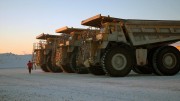Canadian Prime Minister Justin Trudeau made a visit to the annual convention of the Prospectors & Developers Association of Canada (PDAC) in Toronto on March 5, 2019, for a sit-in interview conducted by outgoing PDAC president Glenn Mullan.
Below is a full transcript of the 20-minute interview, edited for clarity. Topics that Trudeau and Mullan discussed included technological innovation, sustainable mining practices, federal regulatory changes and reconciliation efforts with Canada’s First Nations.

Canadian Prime Minister Justin Trudeau (right) being interviewed by outgoing PDAC president Glenn Mullan at the annual convention of the Prospectors and Developers Association of Canada (PDAC) in Toronto on March 5, 2019. Credit: Government of Canada.
Glenn Mullan: We’re so much looking forward to the fireside chat without a fire. And we have a couple of topics that we thought would be agreeable for discussion, including Canada’s competitiveness, Indigenous affairs and some of the regulatory things that we’re working on in collaboration with your government in particular.
There’s a lot of people that work in the mining industry in Canada — about 630,000 — that come from every province, every territory, every community in Canada. And so competitiveness is a key part of our industry, and we face challenges from a broad range of sources, some domestic — cannabis, cryptocurrencies and blockchain — and international, [such as] Australia, and many other countries that compete with us.
But one of the things that we were thrilled to see this year was the renewal of the Mineral Exploration Tax Credit (METC) for five years. Before, each year we met the renewal with relief more than enthusiasm.
Prime Minister Justin Trudeau: Eighteen straight one-year renewals.
GM: That means at one point you’ve got to say, “OK. This is a good thing, let’s do it for five years.” And that’s what we did in the fall. And maybe you could explain a little bit about why your government thought it was important to the minerals industry and mining exploration, in particular.
PMJT: Well, it’s more than just the minerals industry and mining — it’s about industry in general. It’s about businesses and commercial outfits who are doing more and more long-term planning, as we want them to be. You’re making capital investments, you’re looking for the long-term. A mine isn’t something you can open and close in six months. Obviously, you’re looking over a longer period of time. Five years is, for me, giving a bit more stability and predictability, and drawing in investors and building the partnerships and planning for your horizon.
What we want as a country is to demonstrate that Canada is a good place to invest, a good partner to have in your business, and that means listening to your concerns and responding to them, and that’s where we’re giving more predictability on the METC, where we’re highlighting the stability that comes with the trade deals we’ve signed.
You’re obviously an international industry with operations around the world, and in Canada, that is exporting around the world.
The fact that Canada is now the only G7 country with a free-trade deal with every other G7 country — we obviously have access to the U.S., we have access to Europe, we have access to the growing economies of Asia. We are extremely well positioned as a country to continue to engage in the global economy, and making sure we’re competitive within that is really important.
So, the METC for five years is a piece of it.
The accelerated capital cost allowance as well that allows you to write off capital investments in machinery and equipment a lot more quickly is the kind of thing that we’re doing to incentivize you to invest in Canada, and to know that we are your partners right now and for the long-term.
GM: And met with such enthusiasm by our members and delegates in the aftermath. When you ask for three years and you get five, you can only be happy. So, thank you.
The new norm in the world economy is one of cycles, pressures, challenges and competition. That’s no more true than in the minerals and minerals exploration industry. Commodities go up, commodities go down. We all check gold prices, we members in this room check gold prices, nickel, copper.
PMJT: I was asked about the price of gold on my way into the conference. “Prime Minister, any predictions on the price of gold?”
I’m like, “I’m not going anywhere near that question.”
But yeah, I can see it’s a concern. It was about US$1,288.50. There’s a 50% chance it will go up.
GM: But the mining industry is such a key contributor to Canada’s economy. So, 5% of gross domestic product, which is actually a huge number in dollars, it’s about $90 billion — in fact, a little more. About 20% of Canada’s domestic exports and a huge key contributor to royalties and taxes.
Not too many industries brag about the taxes they pay, but we do.
The mining industry is a key creator of jobs, and that’s especially true in Canada’s north and in the remote regions.
On the topic of competitiveness, what can Canada’s mineral industry do with your government to continue enhancing our role?
PMJT: As in general across all different fields of the economy, people are understanding we’re in a time of change right now of transformation of new technologies, of global supply chains, and everyone is trying to adjust to the new realities.
The pace of change accelerating so much over these past years that what we try to do as a country, and what you certainly are doing as an industry is look at where things are going. Go to where the puck is going to be, not where the puck is.
You know that the investments in innovation, in research, in science, in partnerships with Indigenous people are all things that are going to stabilize and give you opportunities to be more competitive in the coming years.

Canadian Prime Minister Justin Trudeau and Governor General Julie Payette speak with Canadian astronaut David Saint-Jacques during a call from Rideau Hall in Ottawa to the International Space Station on Jan. 14, 2019. Credit: Office of the Prime Minister.
It’s interesting because when we think about Canada and Canada’s economy in a historical context, we often go back to, “Oh, we used to be hewers of wood and drawers of water, and now we’re investing in the knowledge economy and AI and robotics.”
But anyone who tries to make a distinction between the resource sector and the knowledge economy is completely missing the boat on what the resource sector in Canada is actually doing.
The level of innovation, the level of research you are doing, the level of investigation and innovation in terms of robotics to go deeper and further, using AI to be more successful in remote locations — that’s where the industry is going, and these are ways that Canada is investing.
I made a big announcement last week on AI and robotics in regards to our space program, but that applies across many industries where you are innovating for the future.
At the same time, what you’re doing is also very much a part of the new economy. We can’t talk about electric cars without recognizing that there’s way more copper wiring in an electric car than in a traditional car. We know solar panels require all sorts of different minerals, a number of which are available and developed in Canada. We know that the kinds of innovations that are coming down the pipe are going to require more and more high-quality processes, productions and products.
And this industry in a stable country like Canada — which is stable politically, geographically, socially, economically, fiscally — is a sound investment particularly because you can count on Canadians to be hardworking, innovative, ambitious, creative, and drive success for your industry and your investors.
GM: Thank you, Prime Minister. And you are certainly a great promoter of our industry as we’ve just heard, and you actually used a hockey metaphor in there.
PMJT: I know you’re a Habs fan, Glenn. So, we’re gonna bond on that one, even here in Toronto. There you go.
GM: And thank you for that. I was actually supposed to open by asserting that the PDAC is more or less our Stanley Cup, but without Connor McDavid or Sidney Crosby.
PMJT: There are far too many Canadians right now who have done well in the PDAC as opposed to at the Stanley Cup, but we’re gonna turn that around this year with a number of good teams.
GM: I hope that to be true. I’d like to move to a completely different topic now and one that I think is important to everyone in this room, and was part of our opening from PDAC executive director Lisa McDonald, when she paid tribute to the Credit First Nation.
So, the topic is Indigenous partnerships and the way that the minerals industry in particular engages with northern communities, communities of Aboriginal people — not just in Canada, but outside. But, in particular, in Canada where there are over 500 such partnerships that we formed with communities and companies. Most have been done in the last 10 years.
I’d like to get your thoughts on the way that the mining industry engages with Aboriginal people in Indigenous communities.
PMJT: First of all, we’ve seen over the past few years that Canadians care deeply, non-Indigenous Canadians care deeply about reconciliation.
We can’t be the country we like to pretend we are on the world stage — standing up for human rights, standing up for equality and opportunity and partnership, and all the good things — if we don’t transform for the better the relationship that has been broken for far too many generations, and indeed centuries, with Indigenous Peoples, with the First Peoples on our land.
So, in the 2015 election, Canadians asked our government very clearly to move forward in partnership and in reconciliation with Indigenous Peoples.
And the government hadn’t done a very good job over the past years of creating those partnerships.
But you know who had in many cases? The mining industry.
You all have been at the forefront of partnerships, of cooperation, of working together with Indigenous Peoples. Just by dint of being so present in remote areas of Canada … that has led to 16,000 Indigenous Peoples working in your industry, which is among the top employers of Indigenous Canadians across the country.
You’ve also developed and worked with them. So, it’s not just direct jobs, it’s supply chain jobs, it’s services that your mines require that are being delivered by Indigenous-owned and operated companies and businesses in the area.
Increasingly, we’re moving towards — and you’re leading the way — on thinking about partnerships that go deeper than not just service agreements, but equity partnerships, partnerships on resource, development and sharing the kinds of things that is recognizing Indigenous Peoples as the original caretakers and stewards of this land. Those kinds of reflections.
There’s still more work to be done on that, and, of course, the government will have an important role in making sure that we remain competitive, that we remain positive, but that people who have been stewards of this land for a long time will be able to fully benefit in the economic output of that land.
These are the kinds of things that you will have already and consistently led on, and we want to continue to work with you on them.
GM: Thank you, Prime Minister. I think the mining industry is pretty well disposed for this conversation in another respect, as well.
Most mining companies are based in major urban centres in Canada: Toronto, Montreal, Vancouver, etc. But the mines, the operations, are very much located in regions, remote areas, which are connected to Aboriginal communities, for the most part.
That’s true in the territories, it’s true in the provinces. I’ve been fortunate to spend a lot of my own experience in Nunavik, Que., in the very Far North, 1,728 km north of Montreal. And the Inuit in that particular part of Quebec are brilliant partners, collaborative partners, and very progressive to work with.
Where do you see room for improvement across the spectrum of minerals industry development in Canada’s North, in particular?
PMJT: Better is always possible. And as you engage in thoughtful ways and look to create deeper and deeper partnerships that go beyond just, say, employer-employee relationship to be more partners in the development, as you have more and more Indigenous leaders and professionals engaging in this industry, I think that’s a logical step.
One of the pieces of it, though, part of recognizing what this industry knows well, is that the way to get projects built now, whether it’s a mine or any sort of resource project, is to do it thoughtfully in partnership with the local communities and local voices.
That’s increasingly true everywhere around the world. There still are some places that try to ram things through and barrel through, but they’re getting more and more resistance on the ground, and they’re getting more and more questions from consumers as to what went into this product that I’m buying, and how is it good for the planet or bad for the planet on multiple, different levels.
That’s something that we’ve recognized as a government, that the only way to get big things built is to do it in respect of science and in partnership with communities — particularly Indigenous communities.
That’s something that we are moving forward with as a key part of our new regulatory frame on Bill C-69.
Quite frankly, the number of thoughtful submissions and amendments to that to improve it [came] from this industry. The measured support for what we’re trying to do is really appreciated, because we know that government can’t just decree that something will be built there anymore in the absence of partnerships consultations, and rigorous processes. And that’s exactly what you’ve understood.
So, we’re moving forward with C-69 in a way that, first of all, takes care of the doubling impact. You no longer will have to go through separate processes that overlap at the provincial and the federal level. There will be one project, one assessment for one project, which is something I know the industry has asked for a long time.
One of the other things in Bill C-69 is that we’re moving forward on something that is already best practices in many parts of your industry, which is doing early assessments, early engagement, that will look at the viability or the challenges around a project before you’ve sunk too much time and energy into it — early consultations and working with communities to be able to highlight and flag some of the challenges you are liable to run into later in the development process, but also give you clarity and investors clarity from early on.
And finally, the fact that it’s now a one-stop shop at the Canadian Environmental Assessment Agency — that you don’t have to run around answering random questions from eight different departments across government is going to be a significant improvement.
But there are a lot of things that we’re doing to give you, as investors and as operators, the kind of certainty and clarity that you need when you’re moving forward, and that’s a big piece of the future of this industry, as well.
GM: Thank you, Prime Minister. I think many of our members recognize that we’re being heard by your government in a way that we perhaps weren’t used to. Bill C-69 is certainly a good manifestation of that, and the METC, as well.
I do want to go back for a moment to reconciliation, because I think that’s an area that most of our members, most Canadians — most of the earth scientists and geologists that work within our industry — are all too familiar.
There is an economic disconnect in northern Canada, in particular, between Aboriginal communities and southern Canada.
The mining industry has been working very hard to try to build bridges where there weren’t any before. That’s also true in parts of Canada where there’s very little infrastructure.
Mining companies bring infrastructure. And reconciliation, like diversity, can mean many different things, but reconciliation means much more to the mining industry than saying, “I’m sorry.”
It’s about building partnerships, building capacity, building improved infrastructure, healthcare, and housing in most of those northern communities.
What does your government see as its role with our industry and in enhancing reconciliation?
PMJT: We recognize that infrastructure investments in remote parts of the country in the north are essential for those communities to thrive. And there’s a lot of discussion of northern sovereignty over the recent years, with climate change making Canada’s North and the Arctic more accessible to shipping and exploration.
Sovereignty in the North and in remote areas has always passed, not through who plants a flag or who has stationed scientists, or even military — it happens of the people who have lived there for millennia. And supporting those communities with good schools, good roads, good jobs, good opportunities is key to actually being the country that we want to be, where everyone has a real and fair chance to succeed regardless of where you are.
A big part of creating that sense of success and resilience within a community comes through jobs. And you can’t have a government determined that this community is going to thrive and take care of just pumping in money. You need economic activity around that, and the natural resource sector is a natural place where we actually draw the value from the minerals from the land that is there.
But if we’re going to do it, we have to recognize that for far too many generations, it was done without the consent, without the participation, without any benefits flowing to the people who had known this land and lived on this land from time immemorial.
What we look at now is recognizing that people want to be successful, they want to have agency over their communities and their success. And that happens in positive partnership with smart investors who are being responsible.
Now, there are always bonds of trust that need to be built and there have been examples of broken trust in the past that [we] are going to need to get beyond.
But the more the industry itself engages in a thoughtful, positive way with Indigenous Peoples and communities as partners who want the same thing, want to draw value from the land and have positive benefit on communities and on the world, then you will find that there are strong alliances and strong stability in the future.
And I know that, because I’ve seen it many, many times — many examples of big companies and junior companies that are doing the right kinds of things that are win-win-wins across the board.

At the launch of Elysis in Montreal in May 2018, from left: Elysis CEO Vincent Christ, Canadian Prime Minister Justin Trudeau, Quebec Premier Philippe Couillard and Rio Tinto Aluminium chief executive Alf Barrios. Credit: PMO.

Canada’s Prime Minister Justin Trudeau (centre) speaks with provincial premiers during the 2015 Paris Climate Conference. Credit: Province of British Columbia.
GM: Thank you, Prime Minister. I don’t think we can really talk about northern Canada and the remote regions without also talking about the environment and sustainability at the same time. And certainly with the PDAC, respect for land, access to land, responsible exploration are very dominant themes.
I’d like to get your thoughts on ways that the minerals industry can continue to work with your government to address and enhance sustainability in a low carbon future environment.
PMJT: A big piece of it is the innovation you’ve always invested in. As you’re looking for ways to lower your costs, inevitably, you’re also looking to waste less, to pollute less.
We know that is a big driver of costs in many situations, particularly in remote areas.
And our customers, clients and partners around the world are expecting, particularly from Canada, high levels of rigour in terms of what you are doing is not negatively impacting on future generations …
So, the kinds of research and innovation you’re doing — a great example is the aluminum industry coming together to do Elysis, where Rio Tinto and the big companies came together to actually develop a new process that doesn’t emit any greenhouse gases, that is zero carbon in terms of creating high-quality aluminum.
Those are the kinds of innovations that people can be confident in, because we know more and more high-tech companies are looking to be able to say that not only are they manufacturing [and using] green power, but the products themselves are low carbon in the emissions in the manufacturing.
So, zero-carbon aluminum, for example, is going to be more and more of a value added to the products that people buy around the world.
As we look at ways of enhancing consumer choices in ways that protect our environment, that recognize the longer-term impacts of what we’re doing, we actually create better value and are including the kinds of consequences and extra analogies that future generations otherwise might have been paying for.
People are looking for responsibility, and I think the mining industry, like many industries, has been really, really thoughtful about saying, “OK. Yes. We need to mine, we need to develop our minerals, we need more copper and rare earth minerals for the electronics we have today.”
But you can’t put a mine anywhere, and when you’re putting a mine in a delicate watershed or a particular protected area, you might have to do more to protect it.
There is a bigger context that you have to be thoughtful about. And I think what citizens expect, what Canadians know, is that you can’t separate what’s good for the environment and what’s good for the economy. You have to do them both together now, we have to create the jobs, the economic growth, the opportunities for future generations.
At the same time as you are not damaging the future of those next generations in terms of the air they breathe and the water they drink. That’s what all Canadians expect, that’s what increasingly people around the world expect.
The more we can think about and innovate in ways that are reaching that, the better off, the more competitive you will be as an industry.
That’s one of the reasons why as a country we’ve made decisions that are making things clearer for you in terms of long-term decisions we make.
We’re putting a price on pollution, for example. Where it’s no longer free to pollute, you will be incentivized as I know you will be to invest in cleaner technologies and to make longer-term investments knowing that if you don’t, your prices are going to rise in a way that is undesirable.
That’s how putting a price on pollution actually helps your industry in the long-term, because we know that the world is going that way, and the more we can do to create a context in Canada in which we’re not just participating in that, but we’re actually leading the way in developing these solutions around the world, then we know that we’re on the right track.
GM: Thank you, Prime Minister. And lithium, cobalt and nickel all come from the products of our industry. I can tell that I’m already getting signals from different sources, so I’d like to thank you for your attendance at our PDAC 2019 convention, Prime Minister. And I look forward to continuing our collaborative discussions.
PMJT: Thank you very much, Glenn. Thank you all for the great work you all do.
RELATED ARTICLE:
Editorial: Federal gov’t unveils Canadian Minerals and Metals Plan
RELATED PODCAST:






Pretty soft interview.